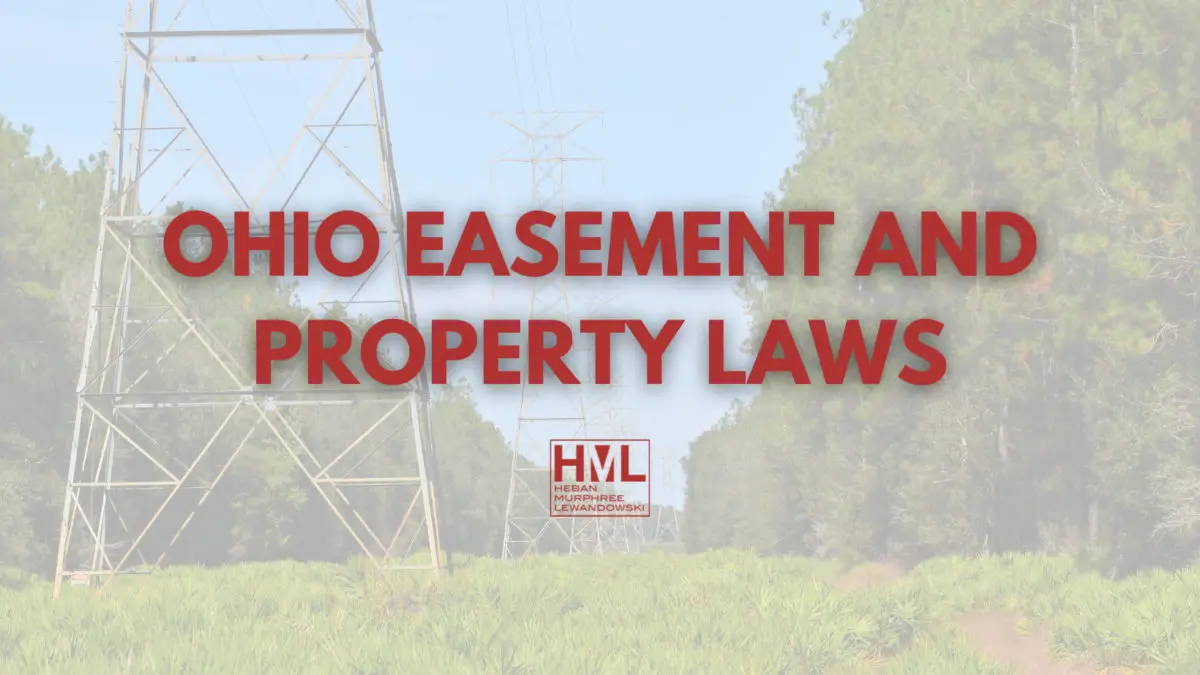- EXPERIENCED LAW FIRM IN TOLEDO, OH
- (419) 662-3100
An In-Depth Examination of Easements and Property Rights in Ohio
Easements and Ownership Rights
Owning property in Ohio is not merely a matter of possession; it entails a comprehensive understanding of the legal intricacies that come with it. Among these complexities, easements and property rights hold a pivotal role.
These legal principles can significantly impact how landowners utilize and enjoy their properties.
What Is An Easement?
An easement represents a property interest that grants an individual or entity the right to use someone else’s land for a specific purpose.
Importantly, this right does not equate to ownership of the land itself. In an easement arrangement, two primary parties are involved: the grantor (the property owner who grants the easement) and the grantee (the easement beneficiary).
Forms of Easements
In addition to utility and access easements, there are several other types of easements in Ohio that play a crucial role in property management and rights. Conservation easements, for example, are used to preserve natural, scenic, or historic areas by restricting certain types of development on a piece of land. This type of easement is particularly important for maintaining ecological balance and heritage conservation. Another form is the driveway or right-of-way easement, which allows individuals to pass through someone else’s property, typically to reach a public road.
There are also emergency access easements, which provide access to emergency vehicles, crucial in rural or otherwise inaccessible areas. Furthermore, Ohio recognizes prescriptive easements, acquired through long-term, continuous use of land without the owner’s explicit permission. Each of these easement types has specific legal implications and requirements, making their understanding essential for property owners and real estate professionals in Ohio.
Dominant and Servient Estates
In real estate, one frequently encounters the terms “dominant estate” and “servient estate.” These concepts play a pivotal role in understanding how easements function in Ohio.
- Dominant Estate – The dominant estate refers to the parcel of real property that benefits from the easement. It essentially represents the property that gains access or utility through the easement.
- Servient Estate – Conversely, the servient estate is the property that grants the easement. It provides the right to access or use for the dominant estate. Understanding this dynamic is crucial in comprehending the responsibilities and rights associated with easements.
Utility Easements Explained
Utility easements are a prevalent and significant type of easement that has a substantial impact on property owners. They primarily involve utility companies needing access to private properties to install and maintain crucial infrastructure such as power lines and pipelines. This access is vital for efficiently delivering essential services like electricity and water to homes and businesses.
Utility easements are characterized by their long-term nature, often lasting for extended periods and sometimes indefinitely. This enduring presence results from the substantial investments made by utility companies in setting up and maintaining their infrastructure, making utility easements a lasting and integral aspect of property ownership.
Why Are Easements Important?
While utility easements significantly impact, easements can also be remarkably simple, serving straightforward purposes. An easement can, for instance, grant a neighbor the right to drive across your property temporarily. These limited-purpose easements are typically less complex, may have shorter durations, and are easier to manage.
Ohio’s thriving oil and gas industry often relies on easements to facilitate its operations. Energy companies frequently seek easements to lay pipelines across various properties, streamlining the drilling process and ensuring efficient resource extraction.
Common Legal Issues With Easements
Property owners can be entangled in complex legal matters when dealing with easements. These legal challenges can be multifaceted and may necessitate legal intervention to resolve. Here are some common legal issues that property owners may encounter about easements:
- Interference Disputes: Easement rights can be a source of contention, with property owners sometimes obstructing the rights of others or interfering with their access to the easement. These conflicts can lead to legal battles over the proper use of the easement.
- Location and Boundary Disagreements: Determining the exact boundaries and locations of easements can be a source of dispute. Property owners may differ in their interpretations of where the easement begins and ends, leading to legal conflicts over property access.
- Abandonment Claims: Easements not actively used can become subject to abandonment claims. Property owners may seek to have unused easements legally declared abandoned, which can lead to disputes and legal proceedings.
- Termination Conditions: Easements often come with conditions for termination. Disagreements can arise regarding fulfilling these conditions, such as when an easement was supposed to be temporary but remains in use. Resolving these disputes may require legal action.
- Scope and Maintenance Disagreements: Property owners may have differing interpretations of the scope of activities allowed under an easement and who is responsible for its maintenance. These disagreements can result in legal disputes over easement usage and upkeep responsibilities.
Prescriptive Easements
Prescriptive easements represent another facet of easements in Ohio. They share similarities with the property law concept of adverse possession, which allows individuals to acquire ownership of another person’s property through extended use. However, in the case of prescriptive easements, the focus is on developing the right to use another’s property for a specific purpose.
To establish a prescriptive easement in Ohio, specific criteria must be met. These include open, notorious, adverse, and continuous use for at least 21 years. Such cases require “clear and convincing evidence,” a higher burden of proof than the standard “preponderance of the evidence” used in most civil claims. Property owners should be mindful of these elements when navigating easement-related legal matters.
Protecting Your Property Rights
Safeguarding your property rights is crucial, especially in the context of easement agreements. Here’s how you can ensure your interests are protected:
- Seek Legal Assistance: Consulting with experienced attorneys is essential when dealing with easement agreements. They can offer deep insights and understanding of the terms and implications of these agreements.
- Understand the Terms: It’s important to clearly understand the terms of the easement agreement to safeguard your rights.
- Secure Your Investment: Legal guidance is key in ensuring that your rights as a property owner are protected during easement negotiations, thus securing your long-term investments.
Ohio’s Legal Landscape for Easements
Understanding Ohio’s legal regulations and easement laws is fundamental for property owners. Familiarizing oneself with the legal landscape, including pertinent case studies and legal precedents, is crucial for making informed easement decisions.
Ohio property owners have access to various resources that can help them clarify their rights concerning easements and land use. Leveraging these resources can be invaluable in making well-informed decisions.
Need Legal Help?
Easements and property rights are integral aspects of property ownership in Ohio. Whether you’re dealing with utility easements, prescriptive easements, or negotiating agreements, seeking legal guidance can be invaluable in ensuring your property rights are upheld.
Property ownership in Ohio is not merely about possession; it’s about knowledge, protection, and empowerment. With the support of experienced attorneys and a comprehensive understanding of easements and property rights, you can confidently navigate the complexities of land ownership in Ohio.
For further information and expert assistance with easements and property rights in Ohio, contact our team for a consultation.











